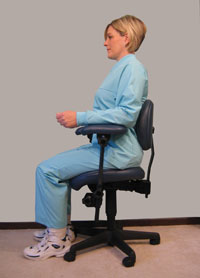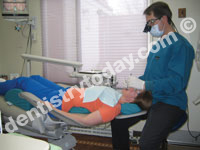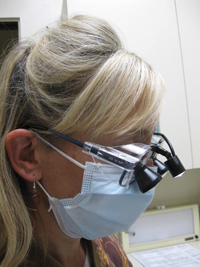Historically, the importance of the dental operator stool has taken a backseat to the patient chair. Fortunately, this mindset is changing as new research is emerging on how various seating options impact a dentist’s musculoskeletal health. From an ergonomic standpoint, the operator stool is the most important chair in your treatment room. The ergonomic features on a stool and how you adjust them can profoundly influence your musculoskeletal health.
The operator stool should adjust to support your body in a neutral back, neck, and shoulder posture. With the wide variety of body sizes and heights among dental operators, certain stool types will fit you better than others. Tall and short operators, who are especially susceptible to pain syndromes due to ill-fitting seating, should be particularly conscientious when assessing special stool features, since these may benefit or worsen their musculoskeletal health.1 The following are basic features to evaluate when selecting traditional-type operator stools with a backrest and/or armrests (Figures 1a and 1b).
TRADITIONAL OPERATOR STOOLS
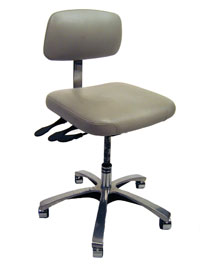 |
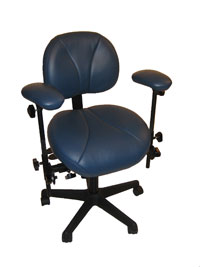 |
|
Figure 1a. An example of a basic stool with adjustable backrest and seat tilt (R04 Stool [Royal]). |
Figure 1b. An example of an adjustable stool with fixed armrests and excellent lumbar support (Bodyguard Stool [Orascoptic]). |
Hydraulic Controls
Nearly all operator stools today have hydraulic controls for easy, smooth adjustment of the stool. Fewer levers under the seat pan will usually make adjustment easier and quicker.
Tilting Seat Pan
When seated, your pelvis becomes the foundation of your posture. The more neutral your pelvic position, the more easily your spinal curves balance. This creates less strain in the back, neck, and shoulders. When seated on a flat seat pan with thighs parallel to the floor (as many dentists were taught in dental school), your pelvis rolls backward and the lumbar curve flattens.2,3 Flattening of the lumbar curve has detrimental effects on both the spinal musculature and discs.2,4,5
Research suggests that the most optimal seated posture for operators is hips higher than the knees, which requires a seat pan design that tilts slightly downward from back to front. This slight downward inclination of the seat pan (from 10° to 15°) helps facilitate the lumbar curve in the low back.6 This increases the hip angle to 105° to 125°, which results in a reduction of muscle activity and disc pressure in the lower back and may also enable a closer position to the patient for the operator.
Seat Contour
The seat contour greatly impacts comfort and support. The front edge of the seat should be padded and have a “waterfall” edge. This feature is especially important to reduce pressure on the posterior thigh’s blood vessels when sitting with your thighs sloping downward.
Seat Depth
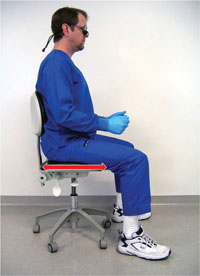 |
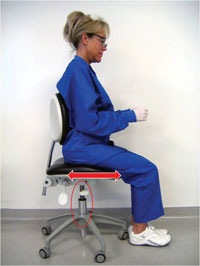 |
| Figure 2a. Seat pan depth should adequately support the operator’s thigh (Spirit Stool [Pelton & Crane]). (Figures 2a and 2b reprinted with permission from Valachi B. Practice Dentistry Pain-Free: Evidence-Based Strategies to Prevent Pain and Extend Your Career. Portland, Ore: Posturedontics Press; 2008.) | Figure 2b. Seat pans that are too deep for the operator may be temporarily modified by angling the backrest forward and retrofitting with a shorter cylinder. |
As manufacturers recognize the growing number of women in the dental profession, more are offering short cylinder options and short seat pan depths to accommodate this population. Dental seat pans range from 14 to 18 inches deep and should support most of your thigh (Figure 2a). When seated all the way back on the seat and in contact with the backrest, the operator should be able to easily fit at least 3 finger widths behind the back of the knee without touching the seat. If the seat pan is too long, modifications should be made to accommodate the shorter dentist (Figure 2b).
Textured Seat
The seat’s material should be textured to prevent slipping when the seat is inclined forward. Materials such as leather are modern and sleek, but these and certain other synthetic types can be slippery, compromising much of the stool’s ergonomic benefits.
Backrest
A backrest with good lumbar support helps maintain the spinal curve when sitting.6 The lumbar support should be convex to support your low-back curve. It need only to be approximately 8 inches in height. This is an especially important feature with nontilting seat pans, which tend to flatten the low-back curve. Lumbar support helps preserve the lumbar curve, reducing muscle activity, disc pressure, as well as back and leg pain.3,7
Five-Caster Base on Rollers
Five casters are essential for safety. Wide wheelbases are more stable, but can be less maneuverable and prevent close positioning to the patient if they hit the patient chair base. Make sure the roller-type is appropriate for your operatory floor (carpet versus hard floor). The wrong rollers can make it difficult to move the chair around the patient.
Armrests
Studies support the use of armrests in the prevention of neck, back, and shoulder pain.8-10 These are especially important for endodontists and dentists who are forced to reach forward with the arms more than 15° due to a protruding abdomen (ie, pregnancy) or a large chest. Armrests should be highly adjustable to provide support to the operator in a neutral working posture. Designs vary widely from fixed-adjustable armrests (Figure 1b) to swiveling and telescoping armrests, which move with the operator. Proper height adjustment of the armrest is essential, since adjusting the armrest too high or too low can lead to a worsening of neck and shoulder pain. Likewise, positioning the armrests too far forward can encourage the operator to lean forward, thus compromising operator posture.
Cylinder Height
The height of the stool cylinder can significantly impact your seated posture and musculoskeletal health. Stools are sometimes sold with a standard height cylinder with little regard to height of individual operators. There is no height standardization for dental stool cylinders. Dental stools marketed as average, medium, standard, or “regular” height may vary widely in adjustability. The adjustments can be found from a low of 13 inches to a high of 30 inches. A “medium” height cylinder from one manufacturer may be called “short” by another manufacturer. In general, it is recommended that a “short” operator have a stool with height adjustment from 16 to 21 inches, and taller operators from 21 to 26 inches.11 Retrofitting a stool with a short or tall cylinder may allow you to better maximize the ergonomic benefits of your stool.1
Saddle-Style Stools
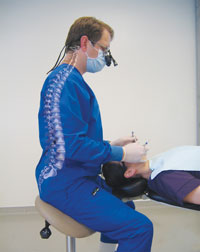 |
| Figure 3. The saddle stool places the pelvis in a near-neutral position, thus naturally balancing the spinal curves. (Figures 3 and 4 reprinted with permission from Valachi B. Practice Dentistry Pain-Free: Evidence-Based Strategies to Prevent Pain and Extend Your Career. Portland, Ore: Posturedontics Press; 2008.) |
When you are sitting in a horse saddle, your pelvis is in a near-neutral position, as in standing posture (Figure 3). This pelvic position allows your spinal curves to balance more easily in proper alignment and reduces muscle strain.12 This is why backrests are considered optional on saddle stools. By design, saddle stools will place more compression on the peritoneal area and should be carefully evaluated for suitability to the operator. Saddle stools have additional benefits: they are great for confined areas due to their very low profile; allow close proximity to patient chairs with thick upper backrests by opening the hip angle; easier to maintain your natural spinal curves when leaning forward; are helpful for tall dentists with low-back pain, since they decrease low-back strain; and they prevent lifting the arms/shoulders in shorter dentists, since they allow for a lower positioning of the patient.
Operator Stool Adjustment To attain a balanced seated posture, follow these adjustment steps:
(Note: If at the highest adjustment your thighs are parallel with the floor, or only very slightly sloping downward, consider ordering a taller cylinder. On the other hand, if you cannot sit all the way back on the seat pan with your weight equally distributed through each foot and buttocks at the lowest adjustment, try a shorter cylinder.) |
Air-Filled Seating
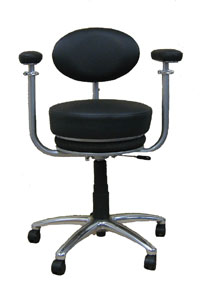 a a |
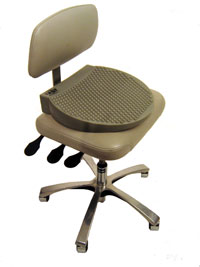 b b |
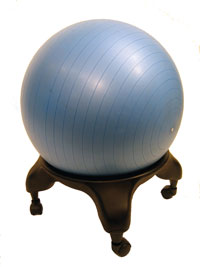 c c |
| Figure 5. Seating styles that utilize an air-filled bladder to allow movement of the spine may help reduce low-back pain: (a) CoreBalance Stool (CoreWerks); (b) ergonomic, wedge-shaped seat cushion; (c) Evolution Ball Chair (Posture Perfect Solutions). |
Studies show that a stool that allows frequent spinal movement may be beneficial in reducing low-back pain.13 These stools may incorporate an air-filled bladder component into the design that follows the operator’s pelvic movements (Figure 5a). This design may also balance the muscle activity in your core stabilizing muscles between the abdominal and lumbar areas, thus improving your working posture. These designs encourage active sitting while not constraining the pelvis to one position, as found in sitting on a traditional, flat seat pan. These innovations allow movement of the spine and pelvis by adapting to your body as you move, not vice versa. Nontilting seat pans may be retrofitted with a wedge-shaped, air-filled cushion to achieve better ergonomic seating and to fully gain the benefits of an air-filled seating system (Figure 5b).
Exercise balls are common fitness tools used by therapists in building patients’ postural core strength. These ball chairs work well in larger operatories, front office areas, and orthodontic or pedodontic operatories. Most ball-seating systems offer leg extensions to accommodate taller workers (Figure 5c).
Another way to simulate spinal movement is to alternate between 2 different seat styles. Consider using a traditional stool (with or without armrests) in one operatory and a saddle-style or air-filled bladder stool in another. Each design uses very different groups of muscles. Also remember to consider intermittently standing for some procedures.
CONCLUSION
The proper selection and adjustment of operator stools play a key role in the management and prevention of work-related pain in dentistry. Since dental equipment technology is constantly changing and advancing, dentists should visit tradeshows to gain knowledge of the most recent offerings in these areas.
References
- Valachi B, Valachi K. Operator seating: the tall and short of it. Dent Today. Jan 2005;24:108-110.
- Harrison DD, Harrison SO, Croft AC, et al. Sitting biomechanics part 1: review of the literature. J Manipulative Physiol Ther. 1999;22:594-609.
- Karwowski W, Marras WS. The Occupational Ergonomics Handbook. Boca Raton, FL: CRC Press LLC; 1999:1765-1766.
- Snijders CJ, Hermans PF, Niesing R, et al. The influence of slouching and lumbar support on iliolumbar ligaments, intervertebral discs and sacroiliac joints. Clin Biomech (Bristol, Avon). 2004;19:323-329.
- Kumar S, ed. Biomechanics in Ergonomics. Philadelphia, PA: Taylor & Francis; 1999:32, 233.
- Chaffin DB, Andersson GBJ, Martin BJ. Occupational Biomechanics. 3rd ed. New York, NY: Wiley-Interscience; 1999:113, 365-382.
- Williams MM, Hawley JA, McKenzie RA, et al. A comparison of the effects of two sitting postures on back and referred pain. Spine. 1991;16:1185-1191.
- Parsell DE, Weber MD, Anderson BC, et al. Evaluation of ergonomic dental stools through clinical simulation. Gen Dent. 2000;48:440-444.
- Schuldt K, Ekholm J, Harms-Ringdahl K, et al. Effects of arm support or suspension on neck and shoulder muscle activity during sedentary work. Scand J Rehabil Med. 1987;19:77-84.
- Schuldt K. On neck muscle activity and load reduction in sitting postures. An electromyographic and biomechanical study with applications in ergonomics and rehabilitation. Scand J Rehabil Med Suppl. 1998;19:1-49.
- Ahearn D. The eight keys to selecting great seating for long-term health. Dent Today. 2005;24:128-131.
- Valachi B. Practice Dentistry Pain-Free: Evidence-Based Strategies to Prevent Pain and Extend Your Career. Portland, OR: Posturedontics Press; 2008.
- McGill S. Low Back Disorders: Evidence-Based Prevention and Rehabilitation. Champaign, IL: Human Kinetics Publishers; 2002:175-177.
Ms. Valachi is a physical therapist, dental ergonomic consultant, and author of Practice Dentistry Pain-Free: Evidence-based Strategies to Prevent Pain and Extend Your Career. She is president of Posturedontics, a company that provides research-based dental ergonomic education, and is clinical instructor of ergonomics at OHSU School of Dentistry in Portland, Oregon. She lectures internationally to dental organizations and has produced exercise videos specifically for dental professionals. She offers free articles and operator stool reviews on her Web site at posturedontics.com, and can be reached at (503) 291-5121 or bethany@posturedontics.com.



